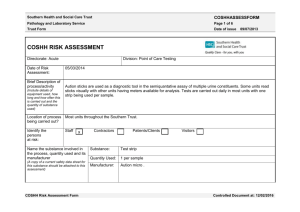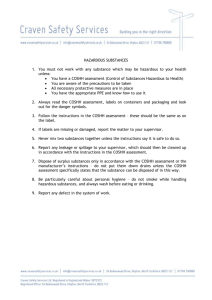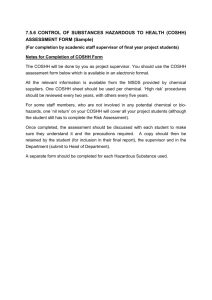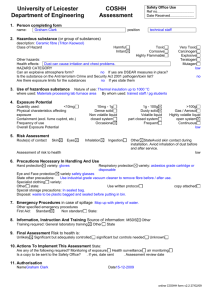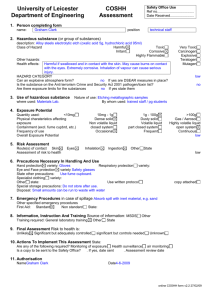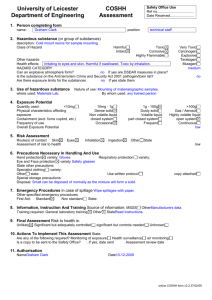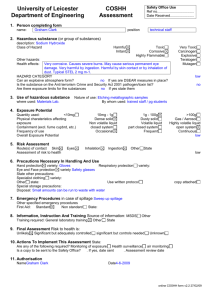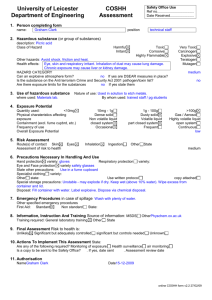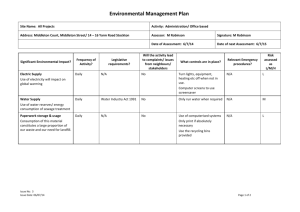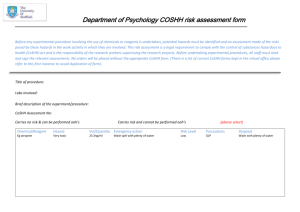Radiometer COSHH
advertisement
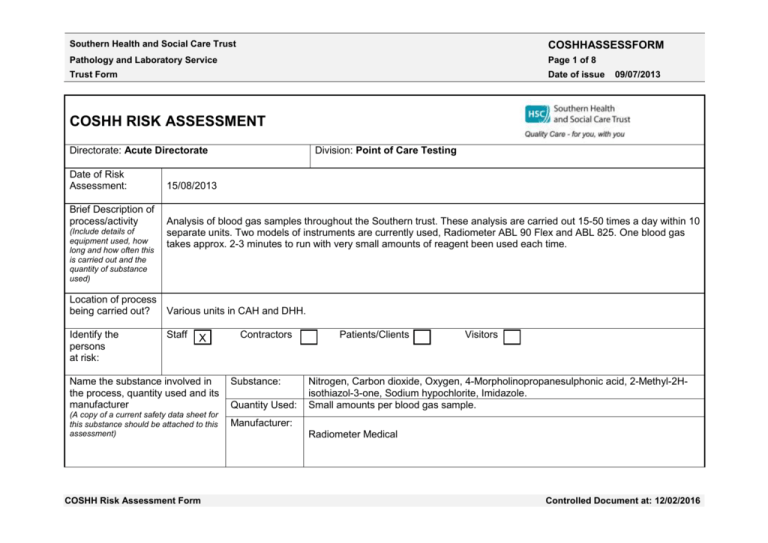
Southern Health and Social Care Trust COSHHASSESSFORM Pathology and Laboratory Service Page 1 of 8 Trust Form Date of issue 09/07/2013 COSHH RISK ASSESSMENT Directorate: Acute Directorate Date of Risk Assessment: Brief Description of process/activity (Include details of equipment used, how long and how often this is carried out and the quantity of substance used) Division: Point of Care Testing 15/08/2013 Analysis of blood gas samples throughout the Southern trust. These analysis are carried out 15-50 times a day within 10 separate units. Two models of instruments are currently used, Radiometer ABL 90 Flex and ABL 825. One blood gas takes approx. 2-3 minutes to run with very small amounts of reagent been used each time. Location of process being carried out? Various units in CAH and DHH. Identify the persons at risk: Staff X Name the substance involved in the process, quantity used and its manufacturer (A copy of a current safety data sheet for this substance should be attached to this assessment) COSHH Risk Assessment Form Contractors Substance: Quantity Used: Patients/Clients Visitors Nitrogen, Carbon dioxide, Oxygen, 4-Morpholinopropanesulphonic acid, 2-Methyl-2Hisothiazol-3-one, Sodium hypochlorite, Imidazole. Small amounts per blood gas sample. Manufacturer: Radiometer Medical Controlled Document at: 12/02/2016 Southern Health and Social Care Trust COSHHASSESSFORM Pathology and Laboratory Service Page 2 of 8 Trust Form Date of issue 09/07/2013 HAZARD SYMBOL AND ABBREVIATION X Explosive Flammable X Corrosive X Oxidising X Compressed Gas Toxic X Environmentally Damaging Irritant Health hazard WARNING AND PRECAUTIONARY STATEMENTS Hazard Statement e.g. H240 Precautionary Statement e.g. P233 (replaces Risk Phrases e.g. R31) (replaces Safety Phrases e.g. S1) H280,R31,R34,R50,H314,H315,H318,H400,EUH 031,R22,R23/24/25,R43,R50/53,R61,H301,H30,H 311,H317,H331,H360D,H400,H410,R8,H270,H28 0,R36/37/38,R43,H319,H335. P410/403,P220b,S17 HAZARD TYPE (TICK ALL THAT APPLY) X X Gas Vapour X Mist COSHH Risk Assessment Form Fume X Dust Liquid Solid Other (State) Controlled Document at: 12/02/2016 Southern Health and Social Care Trust COSHHASSESSFORM Pathology and Laboratory Service Page 3 of 8 Trust Form Date of issue 09/07/2013 ROUTE OF EXPOSURE (TICK ALL THAT APPLY) X Inhalation X X X Skin Eyes Ingestion Other (State) WORKPLACE EXPOSURE LIMITS (WELS) PLEASE INDICATE N/A WHERE NOT APPLICABLE Substance Long-term exposure level (8hrTWA): Short-term exposure level (15 mins): Carbon Dioxide 15 Mins Chlorine 15 Mins STATE THE RISKS TO HEALTH FROM IDENTIFIED HAZARDS Gas or vapour displaces oxygen available for breathing (asphyxiant). In high concentrations: May be harmful if inhaled. Sodium hypochlorite may be corrosive to skin, eyes and mucous membranes (due to the high pH-value).The membrane boxes contain a substance which may cause harm to the unborn child. The product contains very small amounts of Isothiazolone which may provoke an allergic reaction among sensitive individuals. Cartridge based Bag 1: In high concentrations: May be harmful if inhaled. Bags 2-7: The hazardous properties of the product are considered limited. However, the product contains a small amount of sensitising substance which may provoke an allergic reaction among sensitive individuals. COSHH Risk Assessment Form Controlled Document at: 12/02/2016 Southern Health and Social Care Trust COSHHASSESSFORM Pathology and Laboratory Service Page 4 of 8 Trust Form Date of issue 09/07/2013 CONTROL MEASURES: (for example : local exhaust ventilation, fume cupboard, total enclosure,training, supervision). Include special measures for vulnerable groups, such as disabled people and pregnant workers. Take account of those substances that are produced from activities undertaken by another employer’s employees. Carbon dioxide: Provide adequate ventilation. Observe occupational exposure limits and minimise the risk of inhalation. Respiratory equipment: In case of inadequate ventilation, use air-supplied full-mask. Chloride: Provide adequate ventilation. Observe Occupational Exposure Limits and minimise the risk of inhalation of vapours. Personal protection: Personal protection equipment should be chosen according to the CEN standards and in discussion with the supplier of the personal protective equipment (local PPE policy appropriate). Respiratory equipment: No specific recommendation made, but respiratory protection may still be required under exceptional circumstances when excessive air contamination exists. Membrane boxes: Provide adequate ventilation. Minimise the risk of formation of aerosols. Personal protection: Personal protection equipment should be chosen according to the CEN standards and in discussion with the supplier of the personal protective equipment. Hand protection: Wear protective gloves. Nitrile gloves are recommended. Other types of gloves can be recommended by the glove supplier. Eye protection: Wear goggles/face shield. Skin protection: Wear apron or protective clothing. Hygiene measures: Wash hands after handling. Wash contaminated clothing before reuse. Personal protection may not be worn during meal breaks. Cartridge based methods: Provide adequate ventilation. Bag 1: Observe occupational exposure limits and minimise the risk of inhalation. NOTE: Due to the small packaging the risk of inhalation is minimal. Personal protection: Contact with the product is not likely when used according to directions. Respiratory equipment: No special precautions. Due to the small packaging the risk of inhalation is minimal. Hand protection: In case of contact with spilled product: Wear protective gloves. Nitrile gloves are recommended. Eye protection: Risk of splashes: Wear goggles/face shield. Hygiene measures: Wash hands after contact. Is health surveillance required? Yes No X Is environmental/air monitoring required? Yes No X (If yes, refer to Flow Chart for Air Monitoring) COSHH Risk Assessment Form Controlled Document at: 12/02/2016 Southern Health and Social Care Trust COSHHASSESSFORM Pathology and Laboratory Service Page 5 of 8 Trust Form Date of issue Is LEV testing required? Yes No (If yes, refer to Flow Chart for LEV) 09/07/2013 X FIRST AID MEASURES What first aid equipment is available? First aid equipment in line with local hospistal policy. What action should be taken if substance(s) are: Swallowed: Hypochlorite solution/Membrane box/Solution pack: Immediately rinse mouth and drink plenty of water or milk. Keep person under observation. Do not induce vomiting. If vomiting occurs, keep head low. Transport immediately to hospital and bring along these instructions. In contact with Hypochlorite solution: Remove contaminated clothing and flush with plenty of water until pain disappears. If discomfort Skin: persists transport to hospital and bring these instructions. In contact with Eyes: Breathed in: Membrane box/Solution pack: Remove contaminated clothes and rinse skin thoroughly with water. In case of eczema or other skin disorders: Seek medical attention and bring these instructions. Hypochlorite solution/Membrane box/Solution pack: Immediately flush with plenty of water for up to 15 minutes. Remove any contact lenses and open eyelids widely. If irritation persists: Seek medical attention and bring along these instructions. Gas/Membrane box/solution pack: Move injured person into fresh air and keep person calm under observation. If necessary, seek hospital and bring these instructions. Serious cases: If not breathing, give artificial respiration. Other: Storage: please specify how the substance should be stored Gas: Store in a cool and well-ventilated place. See storage temperature on the product label. Do not store near heat sources or expose to high temperatures. Protect against direct sunlight. Hypochlorite Solution/Membrane boxes/Solution pack: See storage temperature on the product label. How should an accidental release/spillage be dealt with? Gas: Allow to evaporate. Provide good ventilation. In case of inadequate ventilation, use respiratory protection. COSHH Risk Assessment Form Controlled Document at: 12/02/2016 Southern Health and Social Care Trust COSHHASSESSFORM Pathology and Laboratory Service Page 6 of 8 Trust Form Date of issue 09/07/2013 Hypochlorite Solution/Membrane boxes: Absorb spillage with suitable absorbent material. Flush away small spillages with plenty of water. Avoid discharge into drains, water courses or onto the ground. Solution pack: Avoid discharge into drains, water courses or onto the ground. Disposal: How should these substance(s) be disposed of? Gas: Make sure containers are empty before discarding (explosion risk). Do not puncture or incinerate even when empty. Hypochlorite Solution/Membrane boxes/Solution pack: Dispose of contaminated packings as residue. Fire Precautions: What actions will be taken in the event of a fire involving these substance(s)? Gas: Use fire-extinguishing media appropriate for surrounding materials. Specific hazards: Containers can burst violently when heated, due to excess pressure build-up. Hypochlorite Solution : Use fire-extinguishing media appropriate for surrounding materials. Specific hazards: When heated and in case of fire, toxic vapours/gases may be formed. Membranes: Use fire-extinguishing media appropriate for surrounding materials. Solution packs: Use fire-extinguishing media appropriate for surrounding materials. Specific hazards: Bag 1: May cause or intensify fire; oxidiser. Considering the size of the packaging, the risk is regarded as minimal. Exposure Control Is exposure adequately controlled? Yes (If No, please complete Action Plan below) X No ACTION PLAN Action Required COSHH Risk Assessment Form Target Date Action by whom Completion date Controlled Document at: 12/02/2016 Southern Health and Social Care Trust COSHHASSESSFORM Pathology and Laboratory Service Page 7 of 8 Trust Form Date of issue 09/07/2013 COSHH Risk Assessor I hereby declare that a suitable and sufficient COSHH assessment has been carried out whereby hazards have been identified, actions suggested and risks prioritised Name: NIGEL QUINN Signature: Date: 16/08/2013 Person in charge/Manager I acknowledge the risks identified by the assessment and will ensure that the risks are reduced as far as is reasonably practicable. Name: DEREK MCKILLOP COSHH Risk Assessment Form Signature: Date: 16/08/2013 Controlled Document at: 12/02/2016 Southern Health and Social Care Trust COSHHASSESSFORM Pathology and Laboratory Service Page 8 of 8 Trust Form Date of issue Review Date (annually) COSHH Risk Assessment Form 09/07/2013 Reviewed by Controlled Document at: 12/02/2016
